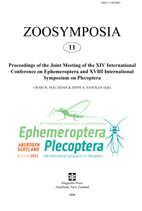Abstract
Spatial heterogeneity is a factor generally considered to promote biodiversity of a given habitat. We studied a colonization of isolated, newly formed pools with different heterogeneity levels (with and without artificial vegetation) and permanence (temporary and permanent). Using mayflies (Ephemeroptera) as a model group, we estimated the effect of spatial heterogeneity on the mayfly community assembly. We found the vegetated pools to host higher species diversity and abundance. Only one species was more abundant in the pools without vegetation. Since the mayfly larvae could not migrate between treatments, differences must be caused either by preferences in female oviposition or different levels of mortality among the treatments. We recorded slightly faster and more synchronized larval development in the non-permanent pools, attributable to the temperature and hydrologic regime.

